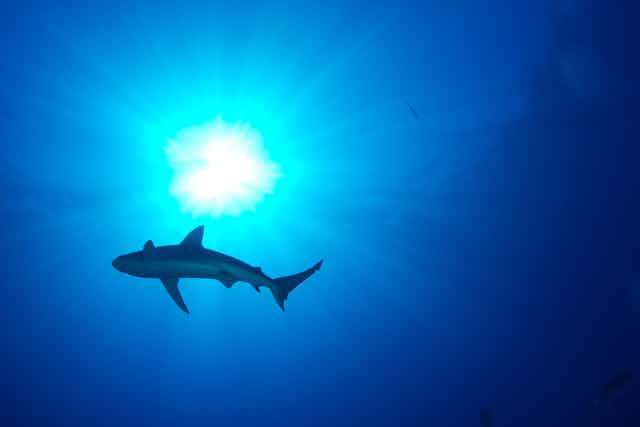The most recent fatal encounter between a shark and a surfer off the coast of Western Australia is a tragic loss of human life. It prompted a Western Australian government reaction to “hunt and kill” the individual animal responsible for the attack. But this is a misguided response, and it’s time we discussed better solutions.
An apparent increase in “shark attacks” has stirred up debates about appropriate longer-term responses, including the possibility of culling sharks to reduce the likelihood of human fatalities. Shark attacks in the past year have been reported amid claims that white shark populations are increasing. But there is a sharp absence of scientific evidence to support this assertion. Rather, increased reports of sightings may indicate change in shark behaviour.
Circulating around these debates is a highly charged public response to both the loss of human life and plans to kill or cull marine animals as a response. There is however, no clear rationale for killing or culling sharks; on this matter governments and the media have been quiet. The governance process that led to the decision to “hunt and kill” in Western Australia remains elusive.
Re-evaluating human behaviour
The conversation about sharks and humans needs to refocus on responses that do not involve killing or culling. Rather than looking at the behaviour of sharks in relation to attacks on humans, it is time to evaluate human behaviour in relation to sharks, and their natural environment.

“Chumming” the ocean to lure sharks close to boats for tourism or recreational fishing is one practice that warrants scrutiny. In Australia and South Africa, tourism industries are now well developed around cage diving and white sharks. Some have suggested that filling the water with blood and fish carcasses to attract sharks close to cages and boats helps them associate a potential meal with the presence of humans.
Scientific evidence is inconclusive. However, at the very least it appears that chumming may alter shark behaviour and movement along coastlines. In light of recent attacks these practices should be discussed.
We can also benefit from using the knowledge we have built up about sharks, both scientific and local knowledge. Accounts from marine biologists, surfers, fishermen and regular beach users hold that entering the water near schools of bait fish is a bad idea. Sharks are often seen chasing small fish schooled together near the surface.
Likewise, swimming near open river mouths (especially after heavy rainfalls), where sharks commonly feed is not recommended. According to accounts by many experienced surfers and fishermen, early morning and dusk are times in the day when the chances of encountering sharks are increased.
Technological interventions provide another set of behavioural responses. On the NSW south coast an aerial patrol is used each summer to spot sharks and warn nearby surfers and swimmers when a sighting occurs. Repellent technology that disturbs sharks’ electroreception organs – their “Ampullae of Lorenzini” – is also being developed. Several companies now sell small battery-powered devices that emit a continuous electrical current. When a shark comes within a few metres it experiences severe discomfort – something like a sharp headache. Testing has shown that the technology can be effective. Devices can be worn by surfers, divers or swimmers and deter sharks without causing long-term harm.
Ethics and philosophy of human - shark relations
Encounters between sharks and humans will continue to occur in Australian waters. Most Australians live near the coast and the ocean is a popular recreational space. When attacks do tragically occur we need to consider a set of deeper philosophical questions and alternative responses:

What right do we have to approve the killing of an animal for inhabiting its natural environment?
What might be a better response?
Researchers from numerous disciplines invest enormous effort into such questions. Within our discipline of geography, there is extensive debate about the cultures and politics of human interactions with “nature”. Many scholars are working towards finding new ways of living ethically in the world, ways that are based on co-existence, and that respond to the challenges of rapid environmental change.
Interestingly, these ideas are consistent with a good deal of public discussion in recent months about appropriate responses to shark attacks. Many commentators – including surfers – call for co-existence rather than killing.
Environmental governance
This brings us to the question: why are we killing these sharks? This is inherently a question about governance. How and why is it that the decision-making process leading to a “hunt and kill” strategy is invisible?
Citizens should be in no doubt about the process that leads to such decisions. When the animal in question is a top-predator and protected species, what are our ethical and political obligations, responsibilities and rights? Whose interests should be heard and heeded? We look forward to forthcoming discussions about the protected status of great white sharks, and hope that deliberations are public.
Milton Friedman once said that crises – actual or perceived – are solved by ideas that are “lying around” at the time. Space needs to be created to allow for a public discussion on the politics of nature and environmental management. We must find alternatives that offer humans a sense of security and safety without delivering death and destruction to another species.
Alternative responses to challenging encounters between humans and sharks are “lying around”. We should think less about killing and culling and more about informed scientific, philosophical and political responses that enable co-existence.

